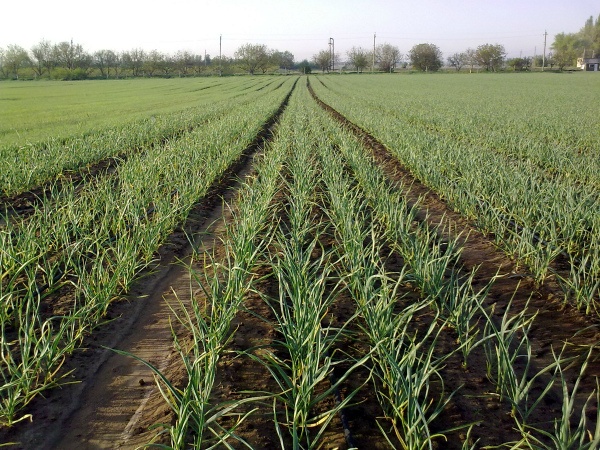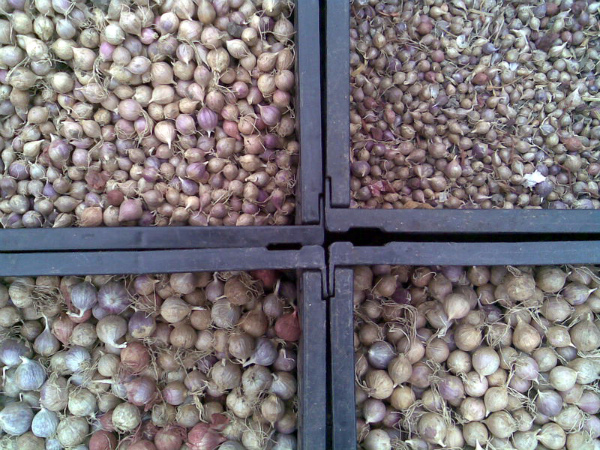When to plant garlic for the winter in Ukraine?
Content
Features of growing garlic in Ukraine
The lands of Ukraine are rich in fertile black soil, so less fertilizers are needed to feed garlic. Moreover, almost throughout the entire territory of the country, the climate is temperate, without unexpected frosts and critically low temperatures, so planting garlic for the winter does without additional insulation of the beds (except for the usual mulching).
There are many varieties of garlic, specially bred for regional characteristics. For example, the Lyubasha variety, if planted and grown correctly, yields a yield of about 35 tons per hectare. The weight of one head reaches 120 grams. The varieties "Ukrainian White" and "Ukrainian Purple" yield up to 20 tons per hectare. The bulbs of this garlic are large, dense, weighing up to 140 grams. You can plant the Spas variety, despite the fact that its bulbs are rarely heavier than 100 grams. But it gives a yield of up to 20 tons per hectare and is resistant to stem nematodes and fusarium.
If the cultivation of garlic is intended for home use in cooking or preservation, then you can plant the variety "Purple Kharkov". He has small bulbs weighing up to 60 grams, but at the same time the yield reaches 100 kilograms per hundred square meters and is practically not susceptible to fungal and bacterial diseases.
Commercial cultivation can be developed by planting the Benefis variety. It is distinguished by high immunity to diseases and harmful insects, yields up to 45 tons of crops per hectare. Bulbs weigh up to 170 grams.
When to plant
So when should the planting of chives take place on the territory of Ukraine? Timing varies depending on the region where the cultivation takes place.In the southern steppe, planting takes place on October 15–25, in the central steppe it is shifted by 5 days - October 10–20. Planting garlic for the winter in the forest-steppe should be October 5–20. Polesie and western regions start planting on October 1-15.
Since the autumn in the region is often warm until the end of October, the planting period extends until November 20. It is important to observe the conditions necessary for good rooting of the seedling, which will facilitate its further cultivation: the soil temperature should drop to 12-13 ° C, the soil should be fertilized and dug up, disinfection should be carried out. This will help the garlic to develop the root system before the first cold weather, which means that when the spring heat comes, the plant will quickly grow.
Garlic needs to store as much sugar as possible in order to survive the winter easily. Thus, the plant can tolerate temperatures as low as -25–30 ° C. One-toothed beetles are well suited to Ukrainian winters, since they are resistant to cold, but you can also plant bulbs.
Planting too early, in August or September, will cause the garlic to sprout too much and will not endure the winter well, which will have a detrimental effect on its further growth. However, late planting will lead to poor development of the teeth, since they will not have time to take root and will most likely not survive the winter.
Landing features
Growing garlic is a laborious process that requires knowledge of how to plant, when to plant, in what soil should be planted. It is best to plant garlic in an open, well-lit area for the winter. At the same time, it is important that water does not accumulate in the beds, since high humidity leads to the activation of fungal spores, and also leads to rotting of the bulbs.
Cultivation should take place on loamy soil with low acidity or on fertile black soil. The more organic and mineral fertilizers the soil contains, the better the crop will be grown.
Soil preparation begins one and a half months before planting for the winter begins. It is necessary to remove all plant residues from the previous culture. It is best to plant a crop after early maturing potatoes, pumpkins, cucumbers, eggplant, legumes and siderates. Growing on such a site will help save on fertilizers, since the soil will be extremely saturated with useful mineral compounds.
The site must be disinfected with fungicidal preparations, for example, using "Fitosporin" or "Topsin-M", as well as insecticides, for example, using "Kruiser" or "Fastak". You can also use a solution of copper sulfate, diluting 40 grams of sulfate in 10 liters of water and watering the beds. Do not ignore this stage, otherwise you risk paying with the harvest when, after waiting out the winter, the pests settle on fresh plantings.
After disinfection, proceed to fertilize the site. Under the digging, 1 bucket of organic fertilizer is introduced (you can take a liquid mullein or horse manure humus), 1 tablespoon of double superphosphate and nitrophosphate. If the soil is acidic, add 1 cup of dolomite flour or slaked lime to this mixture. Such a composition is suitable for fertilizing 1 square meter of the area where garlic cloves are planned to be grown. Dig up by 1–1.5 shovel bayonets, then cover the beds with foil.
Plan the beds so that you can plant the cloves in 10-15 centimeters increments, and keep at least 20 centimeters of free space between the rows. Pour calcined river sand (coarse) on the bottom of the furrow to protect the teeth from rotting in damp soil, moisten it well, and then lay out the cloves, bulbs or seedlings.
You can plant in several ways. For example, you can plant the cloves in two floors. For this, the furrow must be 15–17 centimeters deep. The first layer is laid to the very bottom, then it is covered with earth and the second row of cloves is already laid into it. After the bed is watered and mulched with straw, pine needles or sawdust.
The next method is suitable for bulbs, from which one-tooth bulbs will grow next year. Mark 5 rows, water and fertilize them, and then to a depth of 3 cm, lay out the seedlings 3-4 at a time, keeping a distance between groups of 6 cm. At the end of sowing, cover them with earth and mulch the beds.
The layer of mulch in the beds should be at least 1.5 cm in order to create a natural protection against freezing of sprouts due to snowfall.
Video "Tricks of Planting Garlic"
This video shows you how to grow garlic organically in mulch beds. What are the advantages of this method, watch the video.





